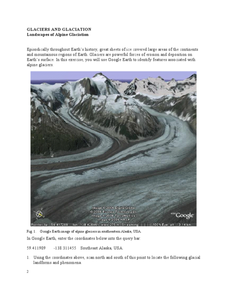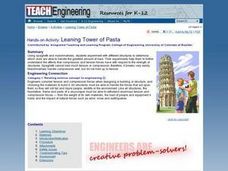Curated OER
Landscapes of Alpine Glaciation
In this glaciers activity, students use Google Earth to look for examples of different glacial landforms and phenomena. Students complete 2 short answer questions.
Curated OER
Capturing the Sun's Warmth
Students explore the variety of ways to use solar energy. They investigate the thermal energy storage capacities of different test materials to determine which to use in passive solar building design. They explain how passive solar...
Curated OER
The Experience of the Child Laborer
Learners make discoveries about the child laborer through a selection of readings. They make connections between the website readings of the child laborers' personal stories and the images that they saw in the previous lesson.
Curated OER
Life in a Hurricane Zone
Students study the nature of hurricanes and examine in detail the effect of Hurricane Georges upon the Dominican Republic. They explain the way in which physical systems (e.g., a hurricane) can affect human systems (e.g., the life of a...
Curated OER
Our Unique Legacy of Giving
Middle schoolers view The Gift of All, a Community of Givers. In this philanthropic instructional activity, students discuss the gifts of philanthropists they've seen. Middle schoolers research and write a two page paper with four bullet...
Curated OER
Differential Thermal Calorimetry
High schoolers access prior knowledge of infrared rays, ultraviolet rays, gamma rays, x-rays and cosmic waves. In this electromagnetic waves lesson, students hold a mock trial electromagnetic spectrum. High schoolers present...
Curated OER
The African Grove Theater
Students study the African Grove Theater in New York. In this African American history lesson, students examine the evolution of race relations in the United States as they research the theater and its history.
Curated OER
April Fool's Day
Students explore tradition and the month of April by participating in practical jokes. In this United Kingdom holiday activity, students discuss the birth of April Fool's day and what it means to the people of England. Students research...
Curated OER
Hip Hop and Geography
Students study the various geographic regions of the U.S. and discuss how popular music is influenced by cultural/regional factors. Groups choose East Coast, West Coast, Midwest, or South in rap/hip hop music and create a PowerPoint or...
Curated OER
Geography: Water, Water Everywhere
Students discuss flooding and its causes. They view a Powerpoint presentation about floods and prevention methods. After creating a model with clay and pans, they investigate river behavior in various terrains with different amounts of...
Curated OER
Electricity: Will It Conduct?
Students build conductivity testers and investigate which solids and solutions conduct electricity. Working in groups, they predict which items will conduct electricity and record their answers on worksheets.
Curated OER
Environment: Wild Wind Direction
Students examine the different types of wind patterns. Using common materials, they construct weather vanes to measure and record wind direction over a two-week period. After analyzing the data, they draw conclusions about the...
Curated OER
Wind Energy
Students explore wind energy by making a pinwheel to model a wind turbine. They experiment with their turbine by placing it in different locations for optimal energy.
Curated OER
Getting to the Point
Students determine location by using the technique of triangulation. They imagine that they are out in the wilderness and have come to the top of a ridge. How can one identify the ridge on the topo map? How can one figure out where you...
Curated OER
What a Drag
Students learn examples of friction and drag, and suggest ways to reduce the impact of these forces. The equation that governs common frictional forces is introduced, and during a hands-on activity, students experimentally measure a...
Curated OER
Where is Here?
Young scholars are shown the very basics of navigation. The concepts of relative and absolute location, latitude, longitude and cardinal directions are discussed, as well as the use and principles of a map and compass.
Curated OER
Build an Approximate Scale Model of an Object
Students create a model of an object of their choice using sketches that they have drawn. They study what a scale model is and how to construct one. They examine the uses for scale models and why they are produced.
Curated OER
Compare Human-made Objects with Natural Objects
Learners examine and observe how many human-made objects get their basic design from things in nature. They listen to the book "Nature Got There First," compare/contrast hollow bones with drinking straws, bird beaks and tool pliers, and...
Curated OER
Design a Recycling Game!
Learners discover that recycling is using a product more than once so that natural resources can be saved and so that we won't need so many garbage dumps and landfills. They see that there are different ways to recycle. Students design a...
Curated OER
Do You Have the Strength?
Students examine the strength and resilience of the human heart. They squeeze a tennis ball to demonstrate the strength of the human heart, record and analyze the results on a worksheet, and create a poster of a design of a device to...
Curated OER
I Feel Renewed!
Learners participate in a simulation of the equal and unequal distribution of the earth's renewable resources. They discuss renewable resources and how food resources can increase and decrease, participate in the simulation, and analyze...
Curated OER
Leaning Tower of Pasta
Students experiment with different structures to determine which ones are able to handle the greatest amount of load using spaghetti and marshmallows. They discuss how engineers design buildings, construct their buildings and complete a...
Curated OER
Smart Move!
Students visualize a communication system. They encode, decode, transmit, receive and store messages. Students use a code sheet and flashlight for this process. They will also maintain a storage sheet from which they can retrieve...
Curated OER
Swing in Time
Students examine the motion of pendulums and come to understand that the longer the string of the pendulum, the fewer the number of swings in a given time interval. They see that changing the weight on the pendulum does not have an...

























